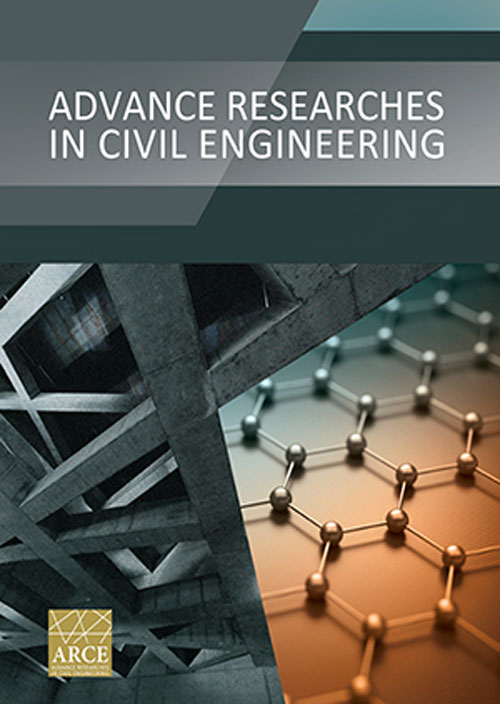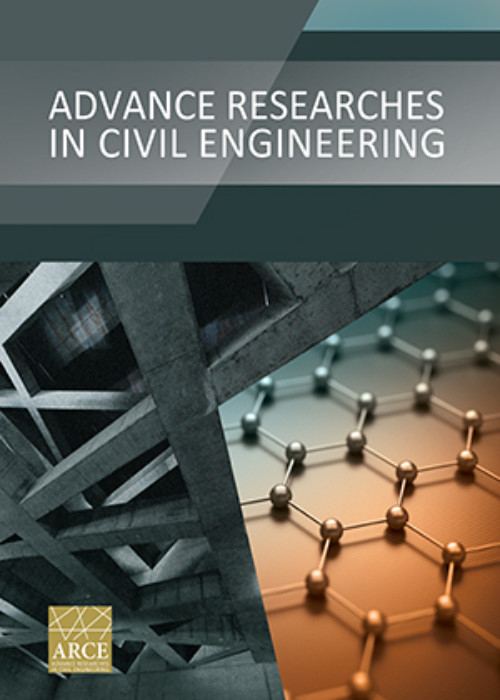فهرست مطالب

Advance Researches in Civil Engineering
Volume:3 Issue: 2, Spring 2021
- تاریخ انتشار: 1400/05/30
- تعداد عناوین: 5
-
Pages 1-15
In recent years, geopolymer has been introduced as a novel and green alternative to the Portland cement. On the other hand, in terms of technical characteristics, concrete has some disadvantages, most notably low tensile strength and consequently low ductility. Therefore, the use of different fibers in the concrete mixture is considered as an appropriate solution to eliminate these defects. In this experimental study, two types of polymer fibers, including simple polypropylene and 4-element polyolefin hybrid fibers, were used to manufacture fiber reinforced geopolymer concrete specimens. In this regard, fiber reinforced and non-fiber specimens were made and associated tests including: density, water absorption, compressive, indirect tensile and flexural strengths, were performed. Also, to study effect of fibers on high-temperature resistance of metakaolin-based geopolymer concrete, specimens weight and compressive strength loss percentage after exposure to high temperatures up to 800 °C, were measured. The obtained results indicated that using fibers in geopolymer concrete mixture, result in increasing compressive, indirect tensile and flexural strengths and also decreasing in density and water absorption. Further, the use of hybrid fibers due to their ability to inhibit the cracking process from both micro and macro levels, significantly improved compressive, indirect tensile and flexural strengths compared to simple fibers. In term of high-temperature resistance, although the polymer fibers reduced the risk of the explosive sapling of specimens, resulting in less weight loss than non-fiber specimen, but overall, it can be concluded that these fibers did not have a significant effect on the high-temperature resistance of geopolymer concrete.
Keywords: Fiber Reinforced Geopolymer Concrete, Hybrid fibers, Polyolefin fibers, Mechanical strengths, High-temperature resistance -
Pages 16-26Beam-column connections with non-seismic detailing in buildings with moment resisting lateral load bearing systems, are the major cause of post-earthquake damage. The optimal shape and energy absorption of the moment frame structure is dependent on the design and perfect execution of the beam-column connections. In the beam-column connections, the lack of positive reinforcement of the beam in the joint area and non-extension of the column stirrup in the joint area are common defects of the joints in accordance with new regulations. In this study, finite element models with seismic and non-seismic detail were considered and validate with laboratory tests by considering sliding effect of longitudinal beam reinforcement using modified steel stress-strain curve. Then, the effect of different lateral beam conditions around the joint was considered. The results showed well that the finite element model is more consistent with the experimental results when considering the slip effects of the longitudinal beam reinforcement. Also comparing the results of the models with the different lateral beam conditions showed that confining the non-seismic joints can increase the joint strength against lateral loads.Keywords: Reinforced Concrete Structures, Beam-Column Connection, finite element modeling, bond-slip, monotonic loading
-
Pages 27-37
In recent years, geopolymers, as a new class of green cement binders, have gained significant attention as an environmental-friendly alternative to Portland Cement (PC) which can potentially reduce negative environmental impacts of PC production such as carbon dioxide (CO2) emissions, energy consumption, natural resources exhaustion and etc. Although the use of geopolymer cement to make concrete has significant environmental benefits, but the technical characteristics of geopolymer concrete should be studied and compared with conventional concrete. Hence, in this experimental study, several technical characteristics of geopolymer concrete including: compressive strength, indirect tensile strength, flexural strength, resistance to acidic conditions, water absorption capacity and resistance to elevated temperatures were studied and compared with conventional concrete. Summarizing the obtained results of this study indicated that geopolymer concrete in addition to major environmental advantages, also has better technical properties in comparison with conventional concrete and can be considered as an acceptable green alternative to conventional concrete.
Keywords: Geopolymer concrete, Conventional Concrete, Mechanical strengths, Resistance to acidic condition, Resistance to elevated temperatures, Permeability -
Pages 38-54
These literature review makes an attempt to study the role of risk management when implementing investment projects. Risk management is an important component of project management. In investment decisions, management must deal with uncertainty in the future either positive uncertainty or negative uncertainty. Risk management is what needs to be considered in investment decisions. The article describes the various types of investment and project risks, methods of risk analysis of investment projects, performance indicators of investment projects, as well as the analysis of risk factors and uncertainties in the course of investment projects’ development. Methods for risk assessment of an investment project help to assess the feasibility of the project, initial time period after which it will generate revenue, as well as the probabilistic size of future profits.
Keywords: risk, Risk Assessment, Risk Management, Investment Project -
Pages 55-71
Compacted clay layers are the most common impermeable layers of earth dams. Due to the specific nature of clay and its unique geotechnical properties, these layers are damaged over time by cracking. The crack healing property of clay is its ability to close up its external cracks and reduce the outflow rate. Hence, in this study, a new method is presented to assess the self-healing phenomenon of clays using pinhole test. In this regard, three soil samples from Vanyar dam (Iran) were treated to obtain the Plasticity Index (PI) between 7 to 26. Different percent of bentonite was added to samples (i.e. 5%, 10%, 15%, 20%) and the impact of bentonite percentage increasing was investigated on self-healing property and outflow rate of clay soil. The obtained results showed that soil dispersion reduced and it became non-dispersive when bentonite was added to the soil samples with the optimum water content and 2% below it. Self-healing phenomenon was visible and predictable with the increase of bentonite in natural soil. For the sample with 20% bentonite, this phenomenon was observed from an early age due to high PI and the potential for high inflation. The sample with 20% bentonite and a moisture content of 2% less than the optimum showed the most reduction in outflow (38%) when compared with the natural soil sample. Therefore, it can be concluded that the PI increment for mixed bentonite-clay soil (between 7 to 26) can increase the self-healing ability.
Keywords: Bentonite, Clay, Core, Pinhole Test, Outflow, Self-healing


